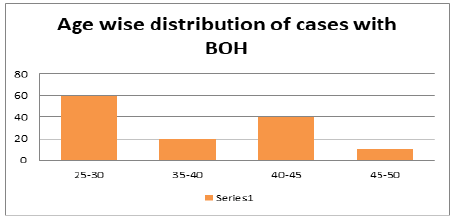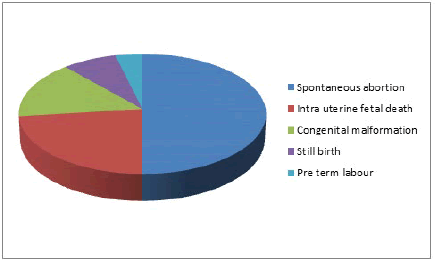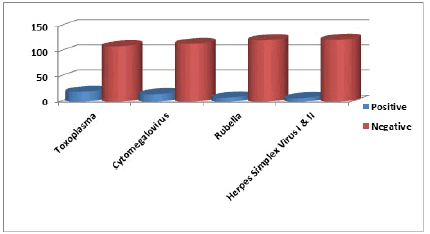Research - International Journal of Medical Research & Health Sciences ( 2022) Volume 11, Issue 8
Sero-Prevalence of TORCH Infections in Pregnant Women with Bad Obstetric History
Sanatkumar Thakershibhai Sahita* and Sachin M. Darji2GCS Medical College, Hospital and Research Centre, Gujarat, India
Sanatkumar Thakershibhai Sahita, B.J. Medical College, Gujarat University, Gujarat, India, Email: sanat61@gmail.com
Received: 16-Apr-2022, Manuscript No. ijmrhs-22-61050; Accepted Date: Aug 21, 2022 ; Editor assigned: 21-Apr-2022, Pre QC No. ijmrhs-22-61050 (PQ); Reviewed: 05-May-2022, QC No. ijmrhs-22-61050 (Q); Revised: 16-Aug-2022, Manuscript No. ijmrhs-22-61050 (R); Published: 30-Aug-2022
Abstract
Introduction: Primary Infection with TORCH Complex (Toxoplasma, Rubella, Cytomegalo virus, and Herpes Simplex Virus I and II) in pregnant women can lead to an adverse outcomes like low birth weight congenital anomalies, sensory neural deafness, mental retardation, cerebral palsy and sometimes to fatal outcomes like abortion and stillbirth which are initially unapparent or asymptomatic and thus difficult to diagnose on clinical ground. Aim: To screen pregnant women with bad obstetric history for TORCH infection to minimize chances of congenital malformation in neonates. Material and Methods: Over one year total of 130 serum samples were collected from antenatal women having bad obstetric history attending tertiary health centres. Samples were screened for IgG antibodies against Toxoplasma, Rubella, Cytomegalo Virus (CMV) by Immuno Comb (EIA) and ELISA Test. Results: It was found that Toxoplasma is the most predominant infection being positive in 20 (15.4%) of the cases followed by 15 (11.5%) for Cytomegalovirus, 8 (6.2%) for Rubella, and 7(5.4%) for Herpes simplex Virus I and II. Conclusion: This study showed that most infections occurred at a young age before or during the first pregnancy. Hence all antenatal cases with bad obstetric history should be routinely screened for TORCH as early diagnosis and appropriate intervention will help in the proper management of the cases.
Keywords
TORCH, Congenital infection, ELISA, Immunocomb
Introduction
Predominantly members of TORCH complex microorganisms including Toxoplasma gondii, Rubella, Cytomegalovirus, and Herpes simplex virus type I and II, infectious agent leads to infection and may enter intrauterine circulation at any gestational age. They sometimes lead to an asymptomatic cause. On the other hand, they may encounter bad prognoses including miscarriage sterility, congenital malformation, and Intra uterine fetal loss [1]. Congenital and prenatal infection represents major causes of permanent disability among children worldwide linked together by the acronym TORCH denoting Toxoplasma, Rubella, Cytomegalovirus, and Herpes simplex virus [2].
The number of human pathogens that crosses the placenta and infect the fetus, these agent causes asymptomatic/mild infection in the mother while serious consequences in the fetus [2].
Maternal Infection plays a critical role in pregnancy wastage and its occurrence in a patient with Bad Obstetric History (BOH) is a significant factor [3].
Most of the information on toxoplasma, in India, is, on pregnancy wastage, Rubella and Cytomegalovirus (CMV) are reported to cause damage to the fetus if acquired during pregnancy [4-7].
Toxoplasma gondii is an intracellular protozoon, an agent of parasitic infection, known as Toxoplasmosis. The spectrum of congenital infection extends from asymptomatic findings up to intrauterine fetal loss and may include chorioretinitis hearing sequelae, hydrocephalus mental and psychomotor disorders [8].
As the gestation weeks progress, the risk of vertical transfer increases, and the risk of infection leading to more serious malformations decrease [9].
CMV is a member of Herpesviridae species, having deoxyribonucleic acid encase in nuclear envelops and may remain as a latent stage inside host cells. It can affect 0.5%-1% of all live birth and it is the most frequently, seen agent of congenital viral infection, which leads to sensorineural deafness and mental retardation [10].
Human Cytomegalovirus (CMV) and Rubella virus are increasingly recognized, as the cause of congenital infection. Intrauterine transmission of CMV to a baby can occur irrespective of prior maternal exposure; whereas in Rubella, a previous exposure prevents the virus from crossing the placenta, by generating protective antibodies [10].
Rubella virus is single-stranded RNA and it is the causative agent of Rubella (German measles), in 20%-50% of patients who have this infection, it leads to an asymptomatic course. In adults and children, the disease manifests itself with adenopathy and severe febrile rashes [11].
Following the Rubella vaccination practices, the incidence of Rubella has been reduced drastically but the World Health Organisation (WHO) still estimates over 1,00,000 Children worldwide are born with congenital Rubella syndrome and more so in developing countries [12].
The risk of fetal infection is at the highest level, during the first 11 weeks and after 36 weeks of gestation if the primary infection is contracted within the first 3 months probability of onset of Congenital Rubella Syndrome (CRS) increases [13].
However, diagnosis of acute Toxoplasma, Rubella, CMV, and Herpes simplex infection can be established by demonstration of zero-conversation pair sera or demonstration of specific IgM antibodies [14].
The mother is the unusual source of transmission of Herpes simplex virus infection during the first half of pregnancy is associated with an increased frequency of spontaneous abortion, stillbirth, and congenital malformation [1].
However, the necessity of screening these infectious agents during pregnancy is a detectable issue. The decision to include TORCH groups of microorganisms in an antenatal screening program in a certain geographic region is based on seroprevalence studies conducted in these regions [2].
Materials and Methods
A total of 130 antenatal cases with BOH attending to Obstetrics and Gynecology OPD of tertiary care centres during one year were included in the present study. To diagnose Toxoplasmosis, Rubella, Cytomegalovirus, and Herpes simplex virus I and II Infection blood samples were collected and subjected to the TORCH test.
Blood Collection: 2 ml of blood was aseptically collected by venepuncture, into a tube containing a clot activator. Blood samples were centrifuged and serum was separated.
Toxoplasma IgG antibody and Cytomegalovirus (CMV) IgG antibody were detected by Smart combat (By Fast EIA), Rubella IgG antibody was detected by Organics (By fast EIA), whereas HSV I and II IgG antibody were detected by ELISA (Globe Diagnostics Srl).
EIA Method: Each tooth is sensitized by two portions; upper spot human IgG (Internal Control) and lower spot inactivated (Toxoplasma, CMV, Rubella) antigen individually. Procedure and interpretation were carried out according to standard kit literature.
ELISA: Procedure and interpretation were carried out according to standard kit literature.
Results
Out of a total of 130 antenatal cases with BOH maximum cases 60 (46.15%) were in the age group of 25 years-30 years followed by 40 (30.76%) in the age group of 40 years-45 years, 20 (15.38%) in the age group 35 years-40 years and 10 (7.69%) in the age group 45 years-50 years (Figure 1).
History of BOH cases consisted of Spontaneous abortion in 65 cases (50%), intrauterine fetal death in 30 cases (23.1%), a congenital malformation in 20 cases (15.38%), stillbirth in 10 cases (7.69%), and preterm labour in 5 cases (3.84%) (Figure 2).
A total of 130 patient’s blood samples were examined for serological test TORCH test by ELISA and Immunocomb IgG. Toxoplasma is the most predominant infection being positive in 20 (15.4%) of the cases followed by Cytomegalovirus 15 (11.5%), 8 (6.2%) for Rubella, and 7 (5.4%) for Herpes simplex Virus I and II (Table 1 and Figure 3).
| Positive | Negative | Total | |
|---|---|---|---|
| Toxoplasma | 20 (15.4%) | 110 (84.6%) | 130 (100%) |
| Cytomegalovirus | 15 (11.5%) | 115 (88.5%) | 130 (100%) |
| Rubella | 8 (6.2%) | 122 (93.8%) | 130 (100%) |
| Herpes simplex virus I and II | 7 (5.4%) | 123 (94.6%) | 130 (100%) |
Table 2 shows mixed infections. 7 cases were having Toxoplasma and Rubella infections and 1 case was having Toxoplasma and Cytmegaloviral infections. 04 cases were having Cytomegaloviral infection with Rubella and 1 case was having Cytomegaloviral infection with Herpes simplex virus type II.
| Presentation | Toxoplasma +ve | Rubella +ve | CMV +ve | HSV +ve |
|---|---|---|---|---|
| Spontaneous abortion (n=65) | 15 (23.1%) | 7 (10.76%) | 4 (6.15%) | 2 (3.1%) |
| Intrauterine death (n=30) | 2 (66.6%) | 4 (13.3%) | 1(3.33%) | 1 (3.33%) |
| Congenital malformation (n=20) | 2 (10%) | 5 (25%) | 2 (10%) | 0 |
| Still birth (n=10) | 2 (20%) | 3 (30%) | 1 (10%) | 0 |
| Pre-term labour (n=5) | 2 (40%) | 1 (20%) | 0 | 0 |
Out of 130 cases undergone for TORCH serological test, 80 showed negative results.
Out of 65 patients with a history of spontaneous abortions, maximum seropositivity was for the Toxoplasma gondii 15 (23.1%).
Out of 30 cases of intrauterine death maximum seropositivity for Toxoplasma gondii 2 (66.6%) followed by Rubella 4 (13.3%), CMV 1 (3.33%) and HSV 1 (3.33%).
Out of 20 females who gave a history of congenital malformation Rubella antibody seropositivity was found most commonly in 5 (25%) cases.
Out of 10 females who gave a history of still birth Rubella antibody seropositivity was found most commonly in 3 (30%) cases.
Out of 10 females who gave a history of pre-term labour Toxoplasma antibody seropositivity was found most commonly in 2 (40%) cases.
Discussion
Limited data is available regarding the prevalence of TORCH infections among pregnant women in general and particularly in this geographic area. Most of the studies in India have related the sero-prevalence to the presence of bad obstetric history. As most of the cases remain asymptomatic, the determination of maternal antibodies in serum is used to detect infection. The reason for low sero-prevalence in the present study may be due to the test being carried out in case of bad clinical history and the cost of the TORCH test also influences in investigation rate as it is one of the costlier serological tests so a patient may be reluctant to undergo test procedure.
In the present study, Toxoplasma IgG antibody was found in 20 (15.4%) samples followed by Cytomegalovirus 15 (11.5%), 8 (6.2%) for Rubella, and 7 (5.4%) for Herpes simplex Virus I and II which is correlating with a study done by Shashi Chopra, et al. [14]. According to Susanta Kumar Sahu, et al. study carried out in Odisha prevalence of Rubella infections was commonest (68.4%) followed by CMV (57.2%), Toxoplasma (38.3%) HSV infection (21.1%) that again suggests that prevalence of these agents depends upon the geographical distribution [15].
Out of a total of 20 (15.4%) IgG antibody-positive Toxoplasma cases, 7 cases had Rubella mixed infection and 01 case was having Cytomegaloviral mixed infection, while 12 cases were having only Toxoplasma infection.
Out of a total of 15 positive cases of Cytomegalovirus IgG antibody 05 (33.33%) cases were having mixed infections with Rubella and 01 case were having Herpes simplex type II.
BOH of spontaneous abortion and pre-term labour was very commonly seen in Toxoplasma infection. Intrauterine death, congenital malformation, and still birth were very commonly seen with Rubella infection [16].
Limitations
We detected IgG antibodies from a single serum sample instead of testing the paired serum samples for titer of IgG antibodies after 2 weeks. We could not test for the detection of IgM antibodies to exclude recent infection as a part of our study. We also could not do the follow-up of our cases till their obstetric outcome. This could have given additional information about the actual burden of the infections.
Conclusion
All antenatal cases with BOH should routinely be screened for TORCH as early diagnosis and appropriate intervention will help in the proper management of these cases.
Declarations
Conflict of Interest
The author(s) declared no potential conflicts of interest with respect to the research, authorship, and/or publication of this article.
References
- Turbadkar, D., M. Mathur, and M. Rele. "Seroprevalence of torch infection in bad obstetric history." Indian Journal of Medical Microbiology, Vol. 21, No. 2, 2003, pp. 108-10.
Google Scholar - Numan, Onur, et al. "TORCH seroprevalence among patients attending obstetric care clinic of Haydarpasa training and research hospital affiliated to association of Istanbul Northern Anatolia public hospitals." Northern Clinics of Istanbul, Vol. 2, No. 3, 2015, pp. 203-09.
Google Scholar Crossref - Mookherjee, N., A. Gogate, and P. K. Shah. "Microbiological evaluation of women with bad obstetrics history." The Indian Journal of Medical Research, Vol. 101, 1995, pp. 103-07.
Google Scholar - Sharma, P., et al. "Increasing toxoplasma seropositivity in women with bad obstetric history and in newborns." National Medical Journal of India, Vol. 10, 1997, pp. 65-66.
Google Scholar - Dashore, S., S. Dube, and V. Pandre. "Maternal Toxoplasmosis in cases of pregnancy wastages." The Journal of Obstetrics and Gynecology of India, Vol. 41, 1991, pp. 17-20.
Google Scholar - Singla, Nidhi, Neerja Jindal, and Aruna Aggarwal. "Primary rubella virus infection: Prevalence and relationship to pregnancy wastage." Indian Journal of Pathology & Microbiology, Vol. 46, No. 4, 2003, pp. 688-89.
Google Scholar - Kapil, A. "Broors. Primary cytomegalovirus infection in pregnancy and non-pregnant women." Indian Journal of Medical Microbiology, Vol. 10, 1992, pp. 53-55.
Google Scholar - Patel, Kamlesh Kumar, et al. "Antenatal detection of IgM and IgG antibodies to Toxoplasma gondii in a hospital from central India." International Journal of Health System and Disaster Management, Vol. 2, No. 3, 2014, pp. 133-35.
Google Scholar Crossref - Feldman, Deborah M., Diane Timms, and Adam F. Borgida. "Toxoplasmosis, parvovirus, and cytomegalovirus in pregnancy." Clinics in Laboratory Medicine, Vol. 30, No. 3, 2010, pp. 709-20.
Google Scholar Crossref - Gibson, Catherine S., et al. "Neurotropic viruses and cerebral palsy: Population-based case-control study." British Medical Association, Vol. 332, No. 7533, 2006, pp. 76-80.
Google Scholar Crossref - Onorato, Ida M., et al. "Epidemiology of cytomegaloviral infections: recommendations for prevention and control." Reviews of Infectious Diseases, Vol. 7, No. 4, 1985, pp. 479-97.
Google Scholar Crossref - Moosavy, Seyed H., "Seroprevalence of rubella virus in women with spontaneous abortion." American Journal of Infectious Diseases, Vol. 7, No. 1, 2011, pp. 16-19.
Google Scholar - Vijayalakshmi, Perumalsamy, et al. "Rubella serosurveys at three Aravind eye hospitals in Tamil Nadu, India." Bulletin of the World Health Organization 82, 2004, pp. 259-64.
Google Scholar - Chopra, Shashi, Usha Arora, and Aruna Aggarwal. "Prevalence of IgM antibodies to toxoplasma, rubella and cytomegalovirus infections during pregnancy." JK Science, Vol. 6, No. 4, 2004, pp. 190-2.
Google Scholar - Sahu, Susanta K., Subrat K. Pradhan, and Lal M. Nayak. "Seroprevalence of TORCH infection among pregnant women." International Journal Of Community Medicine And Public Health, Vol. 6, No. 5, 2019, pp. 2189-94.
Google Scholar Crossref - Sen, M. R., B. N. Shukla, and Banerjee Tuhina. "Prevalence of serum antibodies to TORCH infection in and around Varanasi, Northern India." Journal of clinical and diagnostic research, Vol. 6, No. 9, 2012,p. 1483.
Google Scholar Crossref



